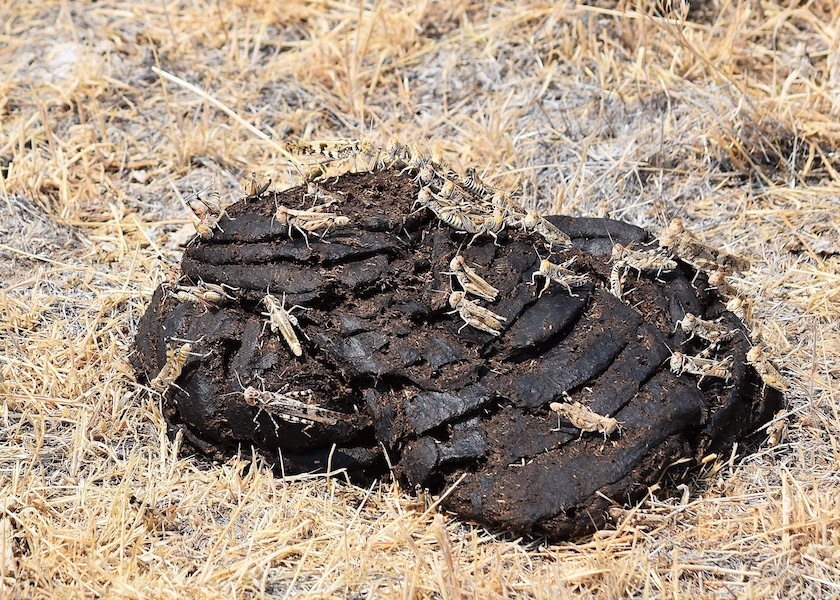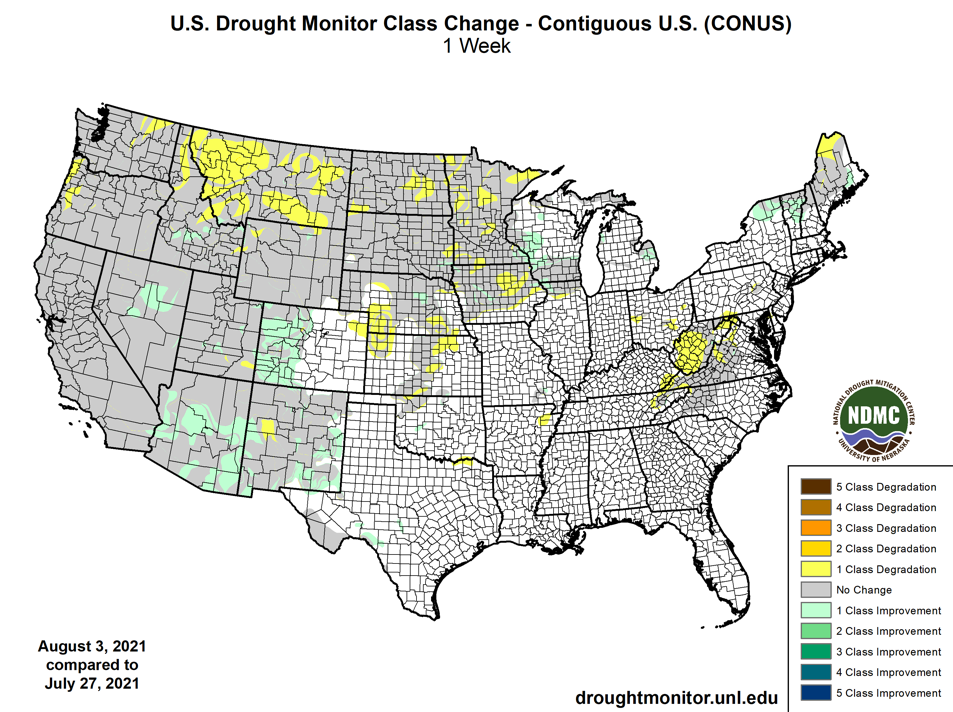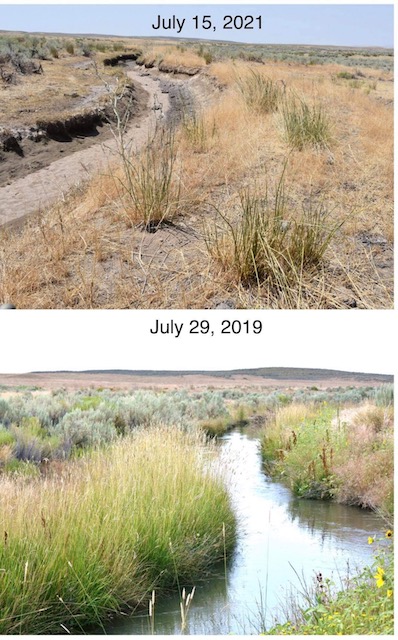Drought and Grasshoppers Ravage Fields in Northwest, Some Producers Bale 10% of Normal Hay Crop
USFR 08/07/21 - Farm Journal Report
Grasshoppers are invading pastures and fields. The corn is so short farmers are forced to chop with a draper head. Ranchers continue to cull cows. The drought in the West is producing many firsts, as farmers and ranchers grapple with dire decisions as the latest U.S. Drought Monitor shows 98% of the West is covered in drought.
“It’s so widespread that I’m afraid it’s going to be pretty devastating to the industry,” says Bob Skinner, a rancher in southeast Oregon. “Hay in our country is going to be really hard to find. Prices are going up every day.”
Conditions are so dire, Skinner had to pull his cattle off federal BLM land more than a month early. The BLM land is a vital summer grazing resource in the Northwest, but this year, the drought took its toll on conditions and he was left with no choice.

“There’s no pasture, anywhere, period around here,” Skinner says. “It doesn’t matter where you go, or how much you pay for it. You can’t find pasture. You couple the drought with the grasshopper situation, and it means a lack of hay.”
North Dakota ranchers have been culling cows since April and May. As drought conditions grew worse, producers were forced to make those dire decisions early. (Read more about the impacts farmers and ranchers are facing due to the drought here.)

Plague of the Grasshoppers
What's adding to the dire drought situation is the plague of grasshoppers. Skinner says the infestation of grasshoppers is so intense, the insects are finishing off any grazing that survived the drought — making a bad situation worse. Skinner says it’s so dire, he’s reached out to state officials to see if APHIS or any other relief efforts could help ranchers in the area.
“I have state officials coming here tomorrow. I think they’re getting tired of listening to me, so they’re coming to look at our grasshopper situation. But they told me they’re not going to be able to do anything. It’s frustrating,” Skinner says.
Skinner says the last time he saw a grasshopper infestation close to this severe was in the 1980s. And then, the federal government stepped in to help.
“The Feds came in and did a huge project on hundreds of thousands of acres,” Skinner says. “They flew five turbines in a V formation, we used tanker loads of malathion and we wiped out the grasshoppers. They were thick, but we wiped them out. This year, nobody wants to do anything.”
Diana Fillmore ranches and lives in southeastern Oregon, as well. As she documents how grasshoppers are wiping out pastures and hay this year, Fillmore reached out to federal officials with APHIS in a plea for help with the grasshopper plague.
"We are talking to county and state officials right now," Fillmore says. "They cannot believe how bad they are. We hope we can get something accomplished this year."
In e-mail correspondence, federal APHIS officials told Fillmore there's nothing that can be done this year to help, as officials say it's too late. Instead, federal officials say they will focus on next year.
"We can make a difference together on this outbreak, which can last for many years if untreated," an APHIS official told Fillmore. "What I am saying is that for the survival and viability of our program, optimal timing is crucial. This requires advanced planning that has not yet occurred in your area, or several areas of the state that are now very keen to do something. In order for us to show biologically effective and well measured results, timing is absolutely critical. As soon as we see first hatch in areas with known problems, we need to have everything in place to start the contracting process. Due to the very short development times we are seeing with the rapidly heating springs, our window for opportunity is measured in days and weeks, not months," the APHIS official told Fillmore.

Grasshoppers are taking over drought-stricken fields all across the North and West.
“Hoppers have taken it down to nothing,” says Trevor Steeke, a Rhame, N.D. producer.
“You can see my 300 acres of barley; all you can see is they’ve eaten it to the ground. There’s nothing left,” Steeke told U.S. Farm Report affiliate KFYR.
In a normal year, Steeke says he would get 1,500 to 3,000 bales on a 1,000-acre field. This year, he baled 53.
“It’s going to be a tough year, a lot of tough decisions are going to have to be made,” Steeke told KFYR.
Photo Courtesy: Diana Fillmore
Culling Cows, Livestock
Steeke already cut his sheep herd from 150 to 38, and in central Wyoming, similar decisions are being made.
“I know people who made some pretty major adjustments real early in May and June because they could see their conditions were bad enough,” says Niels Hansen, a cattle rancher in south-central Wyoming.
Hansen decided several years ago to not keep any cattle during the winter due to limited resources. Instead, he sends his yearlings to market in August and September, but even that’s creating concern this year.
“Some of the rumors that we hear, it looks like a guaranteed loss,” says Hansen in regard to selling cattle this year. “We don’t want to go there. At the same time, we’ve got family farmer-feeders we work with and they’re pretty dependent on our business and they’ve done a good job for us. We’re trying to walk that tightrope.”
Making the situation worse for Oregon ranchers is the fact water is being pulled off hay ground for row crops.
“What worries me as a producer is the long term of this thing,” Skinner says.
Skinner sits on the national Public Lands Council executive committee. He says in talking with producers across the country, his biggest fear is feed costs and availability.
“I’m telling you that this drought situation is so widespread, I’m afraid that just the forage and hay is going to be critical. I don’t see anything other than the fact that people are going to have to start culling their herds pretty quick,” Skinner adds.
Where’s the Water?
Farmers and ranchers in the Klamath River Basin are also dealing with a water crisis. Federal regulators shut off irrigation water to farmers in the reservoir earlier this year.
“Normally, I make about 600 tons [of hay] a year; I sell half of that and the other half goes to my cows. This year, I got 60 tons, so 10% of my normal,” says Ty Kliewer, an Oregon producer and president of the Klamath Irrigation District.
Now, instead of having enough hay to feed, he’s forced to buy feed.
“I’m going to feed all the hay I made, and we’re going to have to feed a lot longer this year. Long story short, I’m looking to buy about 400 tons of hay, if I can find it,” he says.
Just this week, USDA announced it’s investing 15 million in the Klamath River Basin. The money will be used for a new drought pilot program USDA says will provide relief to producers.
“That definitely will help, yes,” Kliewer says. “Is it enough to make people whole? No. But is it enough to hopefully keep people alive? I do think it will definitely help the people here in the basin.”
Emergency Haying and Grazing CRP
Carah Hart, a reporter for Red River Farm Network who covers agriculture in Minnesota, North Dakota and South Dakota, says farmers and ranchers, no matter where they are in the region, are feeling the impacts of drought.
The latest U.S. Drought Monitor shows no improvement in those three states. USDA recently announced it would allow emergency grazing and haying on CRP land, but Hart says even that solution is hitting roadblocks.

“If a county qualifies for emergency haying and grazing CRP ground then it also qualifies for the livestock forage program and only certain CRP practices can be hayed, limiting what’s available,” Hart says.
Under certain circumstances, emergency haying or grazing CRP ground can result in a 25% reduction in CRP payments. While the drought relief isn’t perfect, the issues would take an act of Congress to fix.
“To get permanent changes, people are going to have to make changes to the farm bill,” Hart adds.
While not perfect, Hart says producers such as Jake Thompson of Barnesville, Minn., decided to put up hay on his CRP ground last week, fearing his severe drought conditions could become worse.
“He’s trying to get what he can,” Hart says. “He’s not just going to keep that for himself. He’s got cattle to feed, some cow-calf pairs, but he also has in-laws in North Dakota, I think, who are going to be using some of that.”
From the drought-stricken fields in the west to Capitol Hill, calls for help continue, as the drought situation grows more desperate by the day.









